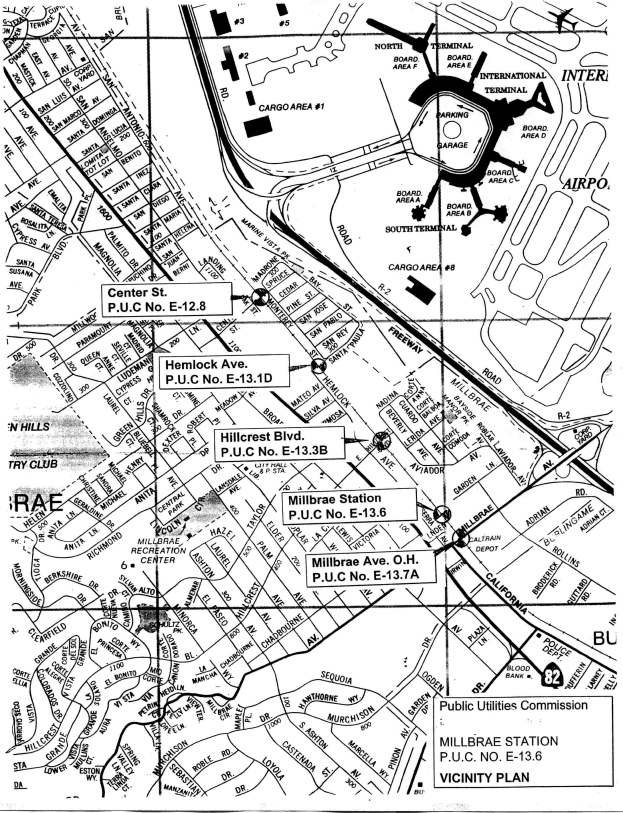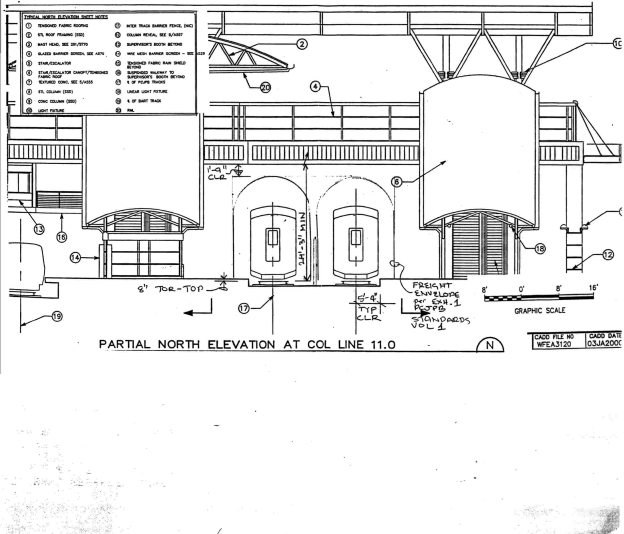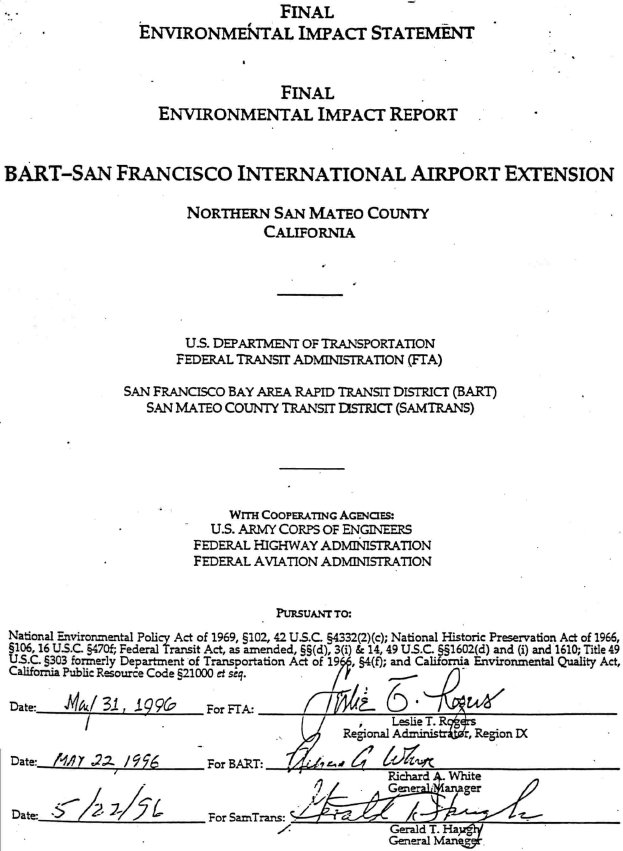Discussion
As part of its extension to the SFIA (Extension), BART has built a grade-separated pedestrian rail-crossing above the tracks of the JPB, at the new Millbrae intermodal station in the City of Millbrae, County of San Mateo. The Extension, in addition to bringing BART to SFIA, will link BART to Caltrain, via the intermodal station located in Millbrae. A sketch of the project area is set forth as Appendix A of this decision. BART has built the pedestrian crossing prior to Commission approval. The Commission has safety oversight of all rail crossings within California, through California Public Utilities Code Sections 1201 through 1205, and Section 7537. The Commission staff informed the applicant early in the Extension project phase that formal applications would be required for the proposed rail crossings on the Extension project. On October 5, 2000, BART filed Application (A.) 00-10-003 for an Order Authorizing Construction of a Crossing of Separated Grades Between Hillcrest Boulevard and the tracks of the Joint Powers Board-"Hillcrest Boulevard Underpass," PUC No. E-13.3B. On November 2, 2000, the Commission issued Decision 00-11-012 that granted BART's request in A.00-10-003. BART filed this application on March 25, 2003. BART seeks authorization for this crossing prior to the opening of services on June 22, 2003.
The Extension is intended to reduce automobile traffic to the airport, and relieve associated problems with gridlock at departure drop off, and arrival pick up, and parking problems. In addition, the intermodal transit facility located in Millbrae will allow greater utilization of Caltrain for BART patrons, and vice versa, potentially reducing traffic congestion along the peninsula.
BART is the lead agency for this project pursuant to the National Environmental Policy Act of 1969 and the California Environmental Quality Act of 1970 (CEQA), as amended, Public Resources Code 21000 et seq. On August 30, 1996, in compliance with CEQA, BART filed its Notice of Determination with the Federal Transit Authority, approving this project stating that the project will have a significant effect on the environment. Accordingly, BART adopted mitigation measures as a condition of approval of the project, and submitted a Statement of Overriding Considerations for the project. Pursuant to CEQA Section 21081.6, BART is also adopting a Mitigation Monitoring Plan, to ensure all mitigations measures are implemented.
The Commission is a responsible agency for this project under CEQA (Public Resources Code Section 21000 et seq.). CEQA requires that the Commission consider the environmental consequences of a project that is subject to its discretionary approval. In particular, to comply with CEQA, a responsible agency must consider the lead agency's Environmental Impact Report or Negative Declaration prior to acting upon or approving the project (CEQA Guideline Section 15050(b)). The specific activities that must be conducted by a responsible agency are contained in CEQA Guideline Section 15096.
The Commission has reviewed BART's environmental documentation. The environmental documentation consists of the "BART-San Francisco Airport Extension, Final Environmental Impact Report/Final Environmental Impact Statement" (FEIS) (Attachment C), a Notice of Determination and a Statement of Overriding Considerations (SOC). Analysis of potential environmental impacts included: land use and economic activity, community services and facilities, visual quality, hydrology and water quality, transportation, geology, soil and seismicity, cultural resources, biological resources, public health and safety, energy, noise and vibration, construction and air quality. We find these documents to be adequate for our decision-making purposes.
Safety and security, transportation and noise are within the scope of the Commission's permitting process. BART identified potential significant environmental impacts in each of these areas, however, those impacts and the adopted mitigation measures pertained to other aspects of the larger extension project, and not to the construction of the grade-separated pedestrian crossing that is the subject of this application. Briefly, BART identified potential safety and security impacts relating to delays in emergency response services as a result of potential closures/partial closures during construction. However, BART determined that the potential impact remains significant and unavoidable, especially for the Bayside Manor neighborhood near the new Millbrae station.
Noise impacts were identified in the FEIS related to construction and operational periods- in the areas of the Colma cemeteries, Kaiser Hospital in South San Francisco and several residential neighborhoods. The mitigation measures adopted to address these impacts will include specified noise and time restrictions, temporary noise barriers, and special pile driving techniques. These mitigation measures will lower all construction noise impacts to a level below significance.
BART also identified potential impacts during the operational phase related to the wheel-truing-machine and turntable proposed for the Daly City yard, and ground borne noise at sensitive receptors in Colma, South San Francisco, San Bruno, and Millbrae. The mitigation measures will include specified building design changes, and the construction of sound walls and other permanent noise barriers at specified locations. These mitigation measures will lower all operational noise impacts to a level below significance.
Transportation and traffic impacts identified in the FEIS are related to construction and operational periods involving road closures during the "cut and cover" process of constructing subway segments, loss of parking and potential impacts to Samtrans bus service and Caltrain rail service. The adopted mitigations for these impacts include the use of certain detours and road closures, "decking" to reduce vehicular traffic, minimum sidewalk standards, temporary replacement parking, coordination with Samtrans, and advance passenger information bulletins. BART determined that, even with these mitigations, it is likely that street closure impacts due to construction will remain significant and unavoidable during the construction period.
Finally, during the operation of the Extension, potential impacts were identified as reduced Level of Service (LOS)1 at four intersections (Hickey Station exit, Sneath Lane at El Camino Real, Millbrae Avenue at El Camino Real and Sneath Lane at Sears entrance), increased freeway traffic between Millbrae Avenue and Broadway and Millbrae Avenue and Third Avenue in San Mateo, increased parking demands near new BART stations, SFIA patrons using BART parking structures, and a cumulative impact of "weaving" at the US 101/Milbrae Avenue interchange. Mitigations include specified new traffic lanes, new traffic stops, signals and signs, certain restricted parking areas, and BART monetary contributions for potential US 101/Millbrae Avenue reconfiguration and the addition of new lanes on all approaches at Sneath Lane and El Camino Real.
In adopting SOC, BART determined that certain project benefits outweighed the significant and unavoidable impacts and warrant project approval. In particular, the SOC noted the Extension would satisfy a strong regional consensus, as demonstrated by MTC Resolution 1876 and San Mateo and San Francisco ballot measures. Commute travel in the US 101 corridor is heavily impacted by traffic from SFIA, which is in the process of expanding. The Extension provides transit as an alternative to the station. Additionally, the Extension will provide for a decrease of 485,000 vehicles miles compared to the 2010 No Build forecast. For these reasons, the project was determined to be necessary to accommodate traffic growth.
For the environmental impacts identified herein which were determined to be significant and unavoidable, we find that BART reasonably concluded there are sufficient project benefits to warrant project approval. For all other potentially significant impacts related to safety and security, transportation and noise, we find that BART adopted feasible mitigation measures to eliminate or substantially reduce the impacts to less-than-significant levels.
Rail Crossings Engineering Section (RCES) staff has inspected the site of the project. The RCES examined the need for and safety of the crossing and recommends that the requested authority be granted. BART has requested prompt action on its application due to a constrained initial operations schedule.
Application 03-03-047 meets the filing requirements of the Commission's Rules of Practice and Procedure, including Rule 38, which relates to the construction of a public highway across a railroad.
In Resolution ALJ 176-3110 dated April 3, 2003, the Commission preliminarily categorized this application as ratesetting, and determined that hearings were not necessary. No protests have been received. The Commission's Consumer Protection and Safety Division recommends that this application be granted. Given these developments, a public hearing is not necessary, and it is not necessary to disturb the preliminary determinations made in Resolution ALJ 176-3110.
This is an uncontested matter in which the decision grants the relief requested. Accordingly, pursuant to Public Utilities Code Section 311(g)(2), the otherwise applicable 30-day period for public review and comment is being waived.
Assignment of Proceeding
Richard Clark is the assigned Examiner in this proceeding.
1. Notice of the application was published in the Commission's Daily Calendar on April 2, 2003. No protests have been filed.
2. BART requests authority, under Public Utilities Code Sections 1201-1205, to open one grade-separated pedestrian rail-crossing over the tracks of the JPB, identified as PUC Crossing Number 105E-13.62-AD.
3. Public convenience, safety, and necessity require the extension of BART to SFIA.
4. BART is the lead agency for this project under NEPA and CEQA, as amended.
5. The Commission is a responsible agency for this project, and has reviewed and considered BART's environmental documentation upon which BART relied in adopting mitigation measures for the project.
6. On August 30, 1996, BART filed its Notice of Determination approving the project and found that the Extension would have a significant effect on the environment. An SOC was adopted for this project.
7. BART's environmental documents are adequate for our decision-making purposes.
8. Safety and security, transportation and noise are within the scope of the Commission's permitting process.
9. The Commission finds that for each potentially significant impact related to safety and security, transportation or noise, BART adopted feasible mitigation measures to either eliminate or substantially lessen those impacts.
10. The Commission finds that for the environmental impacts determined to be significant and unavoidable, BART reasonably concluded there are sufficient project benefits to warrant project approval.
1. The application is uncontested and a public hearing is not necessary.
2. We adopt and require the mitigations identified in BART's FEIS as well as the SOC for purposes of our project approval.
3. The application should be granted as set forth in the following order.
IT IS ORDERED that:
1. The Bay Area Rapid Transit District (BART) is authorized to open one grade-separated pedestrian rail-crossing over the tracks of the Peninsula Corridor Joint Powers Board (JPB) to be identified as BART/ Caltrain Pedestrian Overpass, PUC Crossing Number 105E-13.62-AD in the City of Millbrae, County of San Mateo.
2. Clearances are in accordance with General Order (GO) 26-D.
3. Walkways conform to GO 118. Walkways adjacent to any trackage subject to rail operations shall be maintained free of obstructions.
4. Construction and maintenance costs shall be borne in accordance with an agreement that has been entered into between BART and JPB (parties). A copy of the agreement shall be filed by BART with Rail Crossings Engineering Section (RCES)
5. Within 30 days of this order, BART shall submit to RCES a completed standard Commission Form G (Report of Changes at Highway Grade Crossings and Separations).
6. This application is granted as set forth above.
7. Application 03-03-047 is closed.
This order is effective today.
Dated June 19, 2003, at San Francisco, California.
MICHAEL R. PEEVEY
President
CARL W. WOOD
LORETTA M. LYNCH
GEOFFREY F. BROWN
SUSAN P. KENNEDY
Commissioners
.





